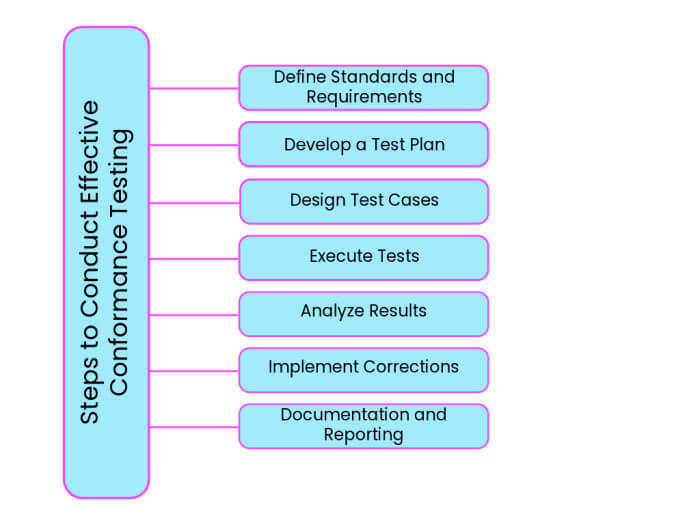
Ensuring that software applications meet specified standards and regulations is more important than ever. Conformance testing, also known as software compliance testing or conformity testing, is the process that helps achieve this. This comprehensive guide will walk you through the essentials of conformance testing, its importance, methodologies, and best practices to ensure your software meets the required standards.
What is Conformance Testing?
“More than the act of testing, the act of designing tests is one of the best bug preventers known.” – Boris Beizer
Conformance testing is the process of validating that a software product or system adheres to a specific set of standards, guidelines, or regulations. This type of testing ensures that the software conforms to external specifications and requirements, which could be industry standards, regulatory requirements, or internal guidelines. These criteria often cover aspects such as efficiency, interoperability, and compliance.

Conformance testing is typically conducted by an authorized individual or organization. Once the software successfully passes this certified testing, it can be marketed as a certified product.
Key Objectives of Conformance Testing
- Verification of Compliance: Ensuring the software adheres to relevant standards.
- Risk Mitigation: Identifying and addressing potential non-compliance issues early.
- Quality Assurance: Maintaining high software quality and reliability.
- Regulatory Approval: Meeting mandatory compliance for regulatory approval.
Although conformance testing is sometimes referred to as compliance testing, there are some clear differences between these testing techniques. Let’s look at the key differences between conformance testing and compliance testing:
| Conformance Testing | Compliance Testing |
| Definition: Conformance Testing is a structured and detailed method of validating that software adheres to specific standards. This type of testing involves rigorous procedures to ensure complete and precise compliance with established guidelines. | Definition: Compliance Testing is a more flexible and less formal approach to verifying that software meets certain standards. It focuses on ensuring the software aligns with some, but not necessarily all, of the required guidelines. |
| Certification: Only operating systems or software products with an official Certification Authority can achieve conformance certification. This formal certification is a testament to the software’s full adherence to the required standards. | Certification: An operating system that supports a single API, such as POSIX (Portable Operating System Interface), is considered compliant. Unlike conformance testing, compliance testing does not require a formal certification authority. |
| Scope: Conformance testing is conducted on systems that fully implement and support the relevant standards. It ensures comprehensive compliance, covering all aspects of the specified guidelines. | Scope: Compliance testing is performed on systems that support parts of the given standards. It ensures partial adherence, verifying that the software meets essential, but not exhaustive, requirements. |
Importance of Conformance Testing
Conformance testing plays a critical role in the software development lifecycle. Here’s why it is indispensable:
Ensuring Quality and Reliability
Conformance testing verifies that the software product functions correctly under specified standards, thereby ensuring its quality and reliability. This process helps detect defects and inconsistencies early, reducing the risk of failures in real-world applications.
Legal and Regulatory Compliance
Many industries, such as healthcare, finance, and telecommunications, have stringent regulations and standards. Software compliance testing is essential to meeting these legal and regulatory requirements. Non-compliance can lead to legal penalties, financial losses, and damage to reputation.
Enhancing User Trust
When software conforms to industry standards, it builds user trust and confidence. Users are more likely to trust and adopt software that is compliant with known standards, leading to higher customer satisfaction and loyalty.
Types of Conformance Testing
Conformance testing can be categorized into three main types: load, stress, and volume testing, each serving a unique purpose in evaluating the performance and reliability of software applications.

Load Testing
Load testing assesses how a software application performs under real-world load conditions. This type of testing simulates multiple users accessing the application simultaneously to determine its behavior under varying loads. The key objective is to measure the system’s response time and performance when subjected to different levels of user demand, ensuring it can handle the expected load efficiently.
Key Aspects of Load Testing:
- Simulates real-world usage by multiple users.
- Measures response times under varying load conditions.
- Helps identify performance bottlenecks.
Stress Testing
Stress testing is focused on evaluating the stability and reliability of a software system under extreme conditions. This testing method pushes the system beyond its normal operational limits to see how it handles high stress and potential failures. By testing under these extreme conditions, stress testing helps ensure that the software can maintain functionality and avoid crashing during peak usage or unexpected surges in demand.
Key Aspects of Stress Testing:
- Tests the system’s robustness and error handling.
- Evaluates performance beyond normal operational limits.
- Ensures the system can handle extreme load conditions without crashing.
Volume Testing
Volume testing involves assessing the software’s ability to manage and process large volumes of data. This type of testing checks how the system performs when handling substantial amounts of data, such as large databases or extensive interface files. Volume testing ensures that the application can process high volumes of data efficiently and without performance degradation.
Key Aspects of Volume Testing:
- Tests the system’s performance with large data sets.
- Evaluates how the software handles extensive data processing.
- Ensures efficient data management and processing capabilities.
Methodologies in Conformance Testing
In addition to the types of testing, conformance testing also involves various methodologies to ensure software meets the required standards. These methodologies are broader approaches or methods used to test different aspects of software compliance.
Standards-Based Testing
This methodology involves testing the software against predefined industry standards, such as ISO, IEEE, or specific regulatory guidelines. The aim is to ensure the software adheres to these standards in functionality, performance, and security.
Key Aspects:
- Ensures adherence to industry-specific standards.
- Verifies compliance with regulatory guidelines.
- Covers functionality, performance, and security.
Interoperability Testing
Interoperability testing ensures the software can operate and communicate seamlessly with other systems and applications. This is crucial for software products that need to integrate with third-party systems or operate in a heterogeneous environment.
Key Aspects:
- Verifies seamless operation with other systems.
- Ensures communication compatibility.
- Crucial for integrating with third-party systems.
Security Testing
Security testing focuses on ensuring that the software adheres to security standards and practices. It involves testing for vulnerabilities, data protection measures, and compliance with security regulations like GDPR, HIPAA, or PCI-DSS.
Key Aspects:
- Identifies security vulnerabilities.
- Verifies data protection measures.
- Ensures compliance with security regulations.
Performance Testing
Performance testing assesses whether the software meets performance standards under various conditions. This includes testing for load handling, response times, scalability, and resource usage.
Key Aspects:
- Evaluates load handling capabilities.
- Measures response times.
- Assesses scalability and resource usage.
Steps to Conduct Effective Conformance Testing
Conducting effective conformance testing requires a structured approach.

Here are the essential steps:
- Define Standards and Requirements: Identify the relevant standards and requirements that the software must comply with. This could include industry standards, regulatory guidelines, and internal policies.
- Develop a Test Plan: Create a comprehensive test plan that outlines the testing scope, objectives, methodologies, resources, and timelines. The test plan should detail the specific standards and requirements to be tested.
- Design Test Cases: Design test cases that cover all aspects of the standards and requirements. Ensure the test cases are detailed and include expected outcomes for each scenario.
- Execute Tests: Execute the test cases systematically and document the results. Use automated testing tools where possible to increase efficiency and accuracy.
- Analyze Results: Analyze the test results to identify any non-compliance issues. Categorize the issues based on their severity and impact on the software’s functionality and compliance.
- Implement Corrections: Address the identified issues and implement necessary corrections. Retest the software to ensure that all non-compliance issues have been resolved.
- Documentation and Reporting: Document the entire testing process and results. Prepare detailed reports highlighting the compliance status, identified issues, and corrective actions taken.
Best Practices for Conformance Testing
To achieve effective and efficient conformance testing, follow these best practices:
Involve Stakeholders Early
Involve all relevant stakeholders, including developers, testers, compliance officers, and regulatory experts, early in the testing process. This ensures a comprehensive understanding of the standards and requirements.
Use Automated Tools
Leverage automated testing tools to enhance the efficiency and accuracy of conformance testing. Automation helps in executing repetitive test cases and provides faster feedback.
Continuous Testing
Incorporate continuous testing practices to ensure ongoing compliance throughout the software development lifecycle. Regularly update test cases to reflect any changes in standards or requirements.
Comprehensive Documentation
Maintain comprehensive documentation of the testing process, including test plans, test cases, results, and corrective actions. This documentation is essential for audits and regulatory reviews.
Training and Awareness
Ensure that your testing team is well-trained and aware of the latest standards and regulations. Continuous training helps in keeping up with evolving compliance requirements.
Challenges in Conformance Testing
While conformance testing is crucial, it comes with its own set of challenges:
Evolving Standards
Standards and regulations are constantly evolving. Keeping up with these changes and ensuring that your software remains compliant can be challenging.
Complexity in Integration
For software that needs to integrate with multiple systems, ensuring seamless interoperability while maintaining compliance can be complex.
Resource Intensive
Conformance testing can be resource-intensive, requiring significant time, effort, and expertise. This can be a challenge for smaller organizations with limited resources.
Handling Ambiguities
Standards and regulations may sometimes be ambiguous or open to interpretation. Clarifying these ambiguities and ensuring accurate testing can be difficult.
Conclusion
Conformance testing is a vital component of software development, ensuring that products meet the necessary standards and regulations. By following structured methodologies and best practices, organizations can effectively conduct conformance testing, ensuring high-quality, reliable, and compliant software.
Mastering conformance testing not only helps in achieving compliance but also enhances the overall quality and reliability of software products. As standards and regulations continue to evolve, staying updated and proactive in conformance testing will be key to success in the ever-changing landscape of software development.









 Marin Levrel
Marin Levrel
 David Parry
David Parry
 Nathaniel Kenvel
Nathaniel Kenvel